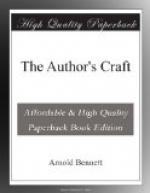The necessarily autobiographical nature of fiction accounts for the creative repetition to which all novelists—including the most powerful—are reduced. They monotonously yield again and again to the strongest predilections of their own individuality. Again and again they think they are creating, by observation, a quite new character—and lo! when finished it is an old one—autobiographical psychology has triumphed! A novelist may achieve a reputation with only a single type, created and re-created in varying forms. And the very greatest do not contrive to create more than half a score genuine separate types. In Cerfberr and Christophe’s biographical dictionary of the characters of Balzac, a tall volume of six hundred pages, there are some two thousand entries of different individuals, but probably fewer than a dozen genuine distinctive types. No creative artist ever repeated himself more brazenly or more successfully than Balzac. His miser, his vicious delightful actress, his vicious delightful duchess, his young man-about-town, his virtuous young man, his heroic weeping virgin, his angelic wife and mother, his poor relation, and his faithful stupid servant—each is continually popping up with a new name in the Human Comedy. A similar phenomenon, as Frank Harris has proved, is to be observed in Shakspere. Hamlet of Denmark was only the last and greatest of a series of Shaksperean Hamlets.
It may be asked, finally: What of the actual process of handling the raw material dug out of existence and of the artist’s self—the process of transmuting life into art? There is no process. That is to say, there is no conscious process. The convention chosen by an artist is his illusion of the truth. Consciously, the artist only omits, selects, arranges. But let him beware of being false to his illusion, for then the process becomes conscious, and bad. This is sentimentality, which is the seed of death in his work. Every artist is tempted to sentimentalise, or to be cynical—practically the same thing. And when he falls to the temptation, the reader whispers in his heart, be it only for one instant: “That is not true to life.” And in turn the reader’s illusion of reality is impaired. Readers are divided into two classes—the enemies and the friends of the artist. The former, a legion, admire for a fortnight or a year. They hate an uncompromising struggle for the truth. They positively like the artist to fall to temptation. If he falls, they exclaim, “How sweet!” The latter are capable of savouring the fine unpleasantness of the struggle for truth. And when they whisper in their hearts: “That is not true to life,” they are ashamed for the artist. They are few, very few; but a vigorous clan. It is they who confer immortality.
PART III
WRITING PLAYS




